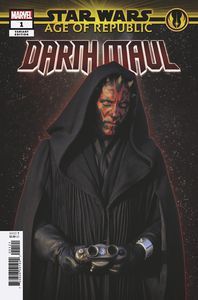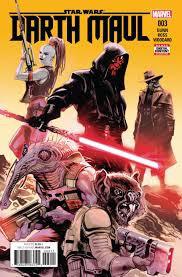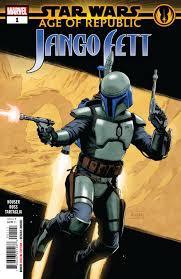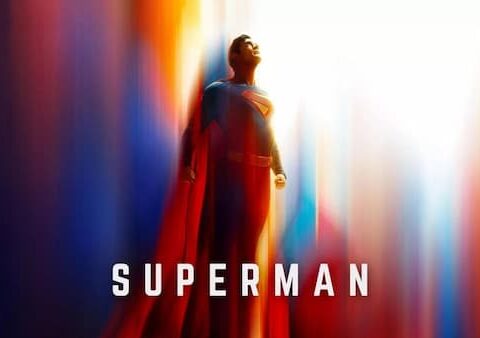As these ‘Age of Republic’ books are so short, I’ve decided to review them two at a time. In this instance, I’ve chosen to put the Darth Maul book and the Jango Fett book together.
Having really enjoyed the Qui-Gon Jinn ‘Age of Republic’ one-shot, I’ve been looking forward to enjoying Marvel’s other releases under that title, which appear to be varied.
I’ll start with the one I liked. Which is Age of Republic: Jango Fett.
I really enjoyed this little story; even though it was the one I was least expecting to be interested in.
I’m not hugely into Jango Fett: but this little book manages to tell a really enjoyable, interesting story that cuts to the core of Jango Fett as a character and his relationship with his son Boba.
It’s also a fun little slice of the Star Wars universe and the prequel era: involving seedy bars and bounty hunters one one hand, and the beginnings of Jango’s real legacy (Kamino, ‘Tyrannus’ and the clones) on the other. There are nice easter-eggs scattered about the story, including Jango’s encounter with ‘Tyrannus’ (Dooku) on the Moons of Bogden (as referenced in Attack of the Clones) and references to other related characters like Zam Wessell and Cad Bane.
But what really lies at the heart of this story is the relationship between Jango and Boba. In that respect, this little story fits in really seamlessly with Attack of the Clones: we see that Boba isn’t just tagging along all the time – but Jango is actually training him all the time, allowing him to observe the game and learn from what goes on. Jango clearly fully intends for the young Boba to follow in his footsteps and be a bounty hunter.
Interestingly, however, we also get to see Boba show some semblance of mercy (well, a mixture of mercy and logic) when he has someone’s life or death in his hands, but chooses to spare the victim.
This is a nice little tale Jody Houser has crafted here: and Luke Ross’s art is really perfect too, making this a visually great book. It helps that the design of Jango Fett lends himself so much to comic-book illustration and colors – more so perhaps than more human-looking characters like Kenobi.
In a nutshell, this Jango Fett book is definitely worth a look.

That said, the Darth Maul installment isn’t something I was all that excited about.
Why? Well, really just because Darth Maul has already been comprehensively covered in comic-book material. Not just Marvel’s own Darth Maul mini-series (reviewed here), but years of Dark Horse books on Maul too, most of it covering the same time-period (specifically, Maul’s life as Palpatine’s apprentice in the lead-in to the events of The Phantom Menace).
It’s a good, interesting area to explore, of course – it’s just that I’ve seen a lot of this already and I don’t know there’s much more to be explored here, at least not in a one-shot.
If it was an ongoing, monthly title set in that period, then fine – we could build and follow a longer, ongoing narrative. But here, it just feels a little pointless.
In this book, we see Maul immersing himself in the seedy underworld of Coruscant’s lower levels, getting mixed up with a criminal enterprise. It’s okayish reading. But nothing substantial.
More interesting is Maul’s vision later on, in which briefly lives out an imaginary life in which he is a Jedi and not a Sith. This was kind of interesting territory, but it doesn’t really going anywhere: he simply shakes himself out of the vision and reasserts that he is a true Sith.
This somewhat highlights the potential problem with having these limited, one-shot stories where you can’t really go anywhere: that Maul vision of an alternate life could’ve been really interesting if explored more broadly.
There are a few nice details in Age of Republic: Darth Maul anyway: the fact that it references and shows Maul’s duel with the Jedi Padawan (I forget her name) from the Darth Maul mini series is cool, showing us that this present story is set some time after those events.
I also spotted some Kylo-Ren-style crossguard lightsabers being wielded by some of the Jedi in Maul’s vision, which is an interesting touch. Even if a tad confusing: if it’s all in Maul’s head, you have to ask why he would insert that detail in there. But if he was drawing the vision from the Force – and somehow seeing elements of real history – then it suggests Kylo’s crossguard design in fact has precedents in older Jedi styles, which is interesting.
At any rate, this book is not essential reading: and it’s not as interesting or informative as the Qui-Gon Jinn book. If you’re a Maul enthusiast, however, I guess you’ll be devouring it anyway.
But the Jango Fett book is better.





